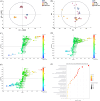In vitro fermentation characteristics of polysaccharide from Scrophularia ningpoensis and its effects on type 2 diabetes mellitus gut microbiota
- PMID: 40343088
- PMCID: PMC12060902
- DOI: 10.7717/peerj.19374
In vitro fermentation characteristics of polysaccharide from Scrophularia ningpoensis and its effects on type 2 diabetes mellitus gut microbiota
Abstract
Background: Increasing evidence has shown a close relation between the pathogenesis of type 2 diabetes mellitus (T2DM), which is a global health problem with multifactorial etiopathogenesis, and gut microbiota.
Methods: During in-vitro fermentation of Scrophularia ningpoensis (known as Xuanshen) polysaccharide (SNP) by T2DM gut microbiota, effects of SNP on the gas content, production of short-chain fatty acids (SCFAs), metabolite profile and microbiota composition were studied.
Results: Analysis of chemical compositions indicates that the total sugar content of SNP was found to be as high as 87.35 ± 0.13% (w/w). SNP treatment significantly improved the gas volume and composition in T2DM fecal matter. Moreover, intestinal flora degraded SNP to produce SCFAs, thus regulating SCFA production and composition. Metabolomic analysis implied that SNP shows potential to regulate the five gut metabolites (L-valine, L-leucine, L-isoleucine, L-alanine, and xylitol) in T2DM fecal matter. Furthermore, dysbiosis of gut microbiota induced by T2DM was reversed by SNP. The evidence includes decreasing Firmicutes/Bacteroidota ratio at phylum level promoting proliferation of the bacterial abundance of Dorea, Parabacteroides, Faecalibacterium, and Lachnospira and decreased bacterial abundance of Escherichia-Shigella. Based on these findings, the action mechanism of SNP against T2DM was clarified by reshaping microbiota and regulating intestinal metabolites, and a novel target was provided for interventions of T2DM.
Keywords: Gut microbiota; Polysaccharide; Scrophularia ningpoensis; T2DM.
© 2025 Zhao et al.
Conflict of interest statement
The authors declare that they have no competing interests.
Figures










Similar articles
-
Fermentation-enriched quinoa β-glucan ameliorates disturbed gut microbiota and metabolism in type 2 diabetes mellitus mice.Int J Biol Macromol. 2025 May;306(Pt 3):141666. doi: 10.1016/j.ijbiomac.2025.141666. Epub 2025 Mar 1. Int J Biol Macromol. 2025. PMID: 40032090
-
Cyclocarya paliurus polysaccharides alleviate type 2 diabetic symptoms by modulating gut microbiota and short-chain fatty acids.Phytomedicine. 2020 Oct;77:153268. doi: 10.1016/j.phymed.2020.153268. Epub 2020 Jun 30. Phytomedicine. 2020. PMID: 32663709
-
Fibroblast growth factor 21 improves insulin sensitivity by modulating the bile acid-gut microbiota axis in type Ⅱ diabetic mice.Free Radic Biol Med. 2024 Nov 1;224:600-617. doi: 10.1016/j.freeradbiomed.2024.09.017. Epub 2024 Sep 15. Free Radic Biol Med. 2024. PMID: 39288846
-
Interactions Between Gut Microbiota, Host, and Herbal Medicines: A Review of New Insights Into the Pathogenesis and Treatment of Type 2 Diabetes.Front Cell Infect Microbiol. 2020 Jul 17;10:360. doi: 10.3389/fcimb.2020.00360. eCollection 2020. Front Cell Infect Microbiol. 2020. PMID: 32766169 Free PMC article. Review.
-
The Role of Dietary Fibre in Modulating Gut Microbiota Dysbiosis in Patients with Type 2 Diabetes: A Systematic Review and Meta-Analysis of Randomised Controlled Trials.Nutrients. 2020 Oct 23;12(11):3239. doi: 10.3390/nu12113239. Nutrients. 2020. PMID: 33113929 Free PMC article.
References
MeSH terms
Substances
LinkOut - more resources
Full Text Sources
Medical

